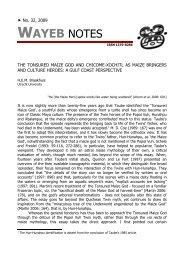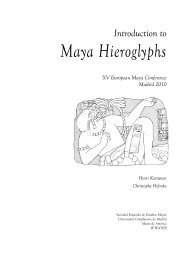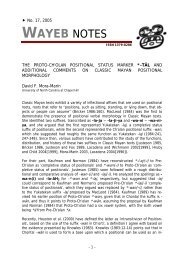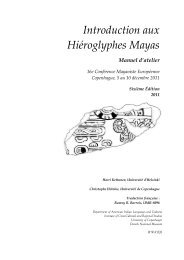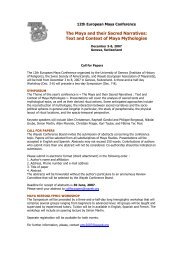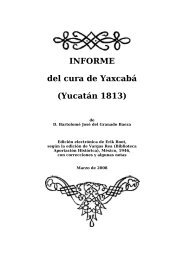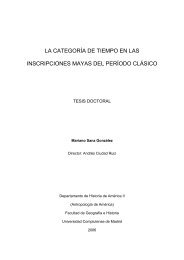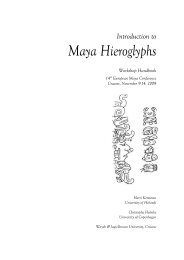Introduction to Maya Hieroglyphs - Wayeb
Introduction to Maya Hieroglyphs - Wayeb
Introduction to Maya Hieroglyphs - Wayeb
You also want an ePaper? Increase the reach of your titles
YUMPU automatically turns print PDFs into web optimized ePapers that Google loves.
Kettunen & Helmke 2011<br />
The Writing System<br />
6. COMPOUND GLYPHS, INFIXING, AND CONFLATIONS<br />
The graphic conventions of <strong>Maya</strong> hieroglyphic writing form a very flexible system, but quite often these are for<br />
the most part just puzzling for an untrained eye. There are a number of ways of writing the same word without<br />
changing the reading and / or meaning. Chum tuun means “s<strong>to</strong>ne-seating” and refers <strong>to</strong> the beginning of the 360-<br />
day period. This can be written in various manners:<br />
CHUM[mu] 33 TUN-ni<br />
CHUM[mu] TUN-ni<br />
CHUM[TUN-ni]<br />
CHUM-TUN (or CHUMTUN)<br />
CHUM with infixed phonetic<br />
complement /mu/ & TUN with<br />
phonetic complement /ni/<br />
CHUM with infixed phonetic<br />
complement /mu/ & TUN with<br />
phonetic complement /ni/<br />
TUN-ni infixed inside<br />
the CHUM glyph<br />
conflation of both signs<br />
independent glyph blocks<br />
compound glyph blocks with<br />
suppressed left sign<br />
infixation<br />
conflation: merging of the<br />
diagnostic traits of two distinct<br />
signs in<strong>to</strong> one<br />
Any one of the arrangements above can occur in any text and more than one can be used in a single text. The<br />
reason for this is both economic and artistic: sometimes the scribe might have run out of space, and sometimes<br />
variations were used <strong>to</strong> avoid repetition or graphemic tau<strong>to</strong>logy (see also the variations with logograms and<br />
phonetic complements below).<br />
In the following example, the metaphorical death statement of Itzamnaaj Bahlam, the king of Yaxchilan, and Lady<br />
Pakal, his mother, is recorded in the same monument in two different (but parallel) ways, with the latter being<br />
compressed <strong>to</strong> cover a space of one glyph block instead of two:<br />
K’A’-yi u-[?]SAK-IK’-li<br />
k’a’ay / k’a’aay u…? [u]sak ik’[i]l / ik’[aa]l<br />
k’a’-ay-Ø / k’a’-aay-Ø u-? [u-]sak-ik’-il / -ik-aal<br />
wither-MPAS-3SA 3SE-? [3SE-]white-wind-POS<br />
“It got withered, his/her ?, his/her white wind/breath”<br />
(Yaxchilan, Lintel 27: A2-B2)<br />
K’A’-yi-u-[?]SAK-IK’<br />
k’a’ay / k’a’aay u…? [u]sak ik’[il] / ik’[aal]<br />
k’a’-ay-Ø / k’a’-aay-Ø u-? [u-]sak-ik’[-il] / -ik[-aal]<br />
wither-MPAS-3SA 3SE-? [3SE-]white-wind<br />
“It got withered, his/her ?, his/her white wind/breath”<br />
(Yaxchilan, Lintel 27: F2)<br />
In addition, different signs of equal phonetic value might be used variably throughout a text, again for aesthetic<br />
reasons. It is due <strong>to</strong> such interchangeability that signs of unknown value can be deciphered if the case is made<br />
that it equates another glyph of known value.<br />
33<br />
Square brackets […] are used in transliterations <strong>to</strong> designate infixed syllables or words (and in epigraphic analysis <strong>to</strong> indicate reconstructed<br />
sounds).<br />
17/154



